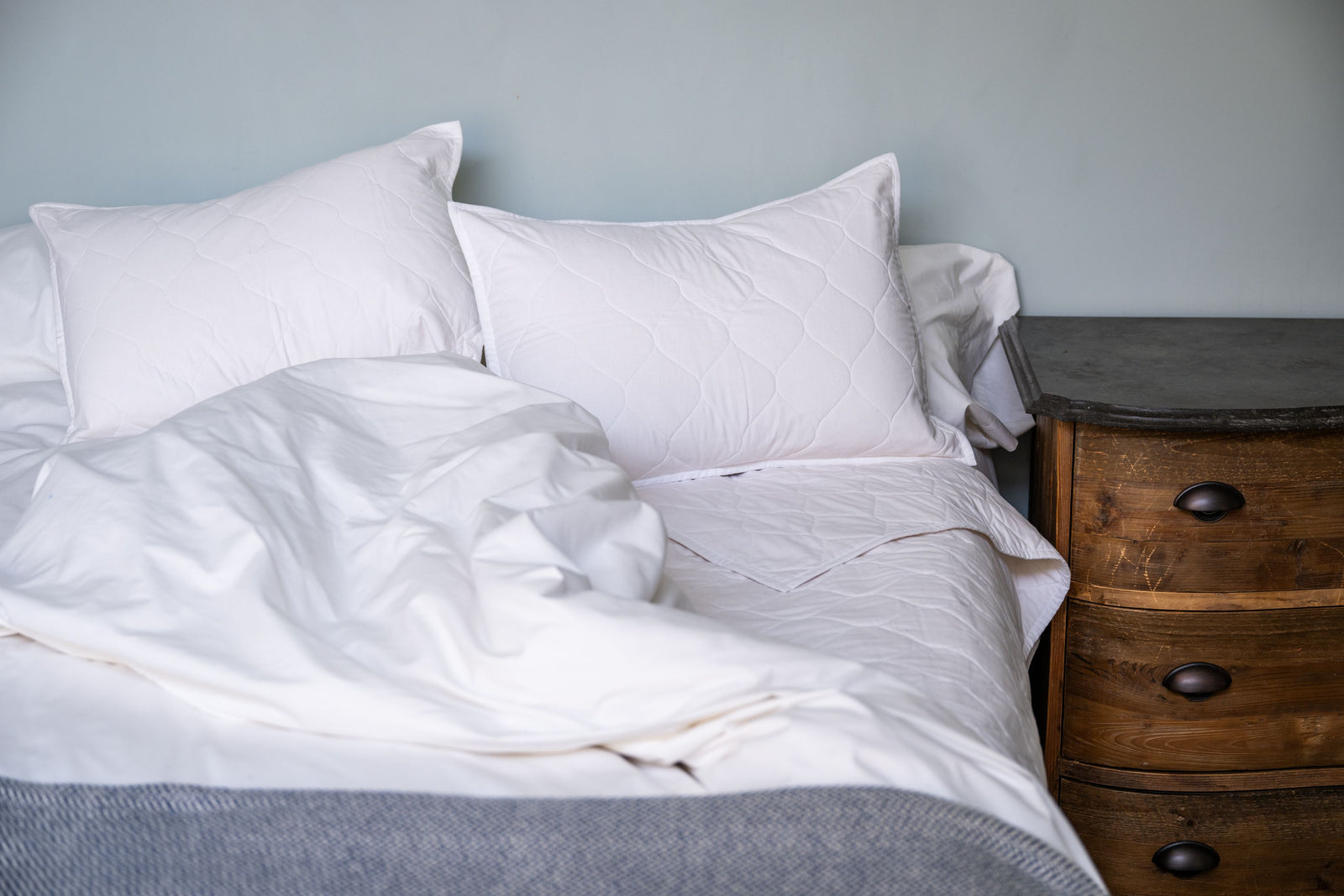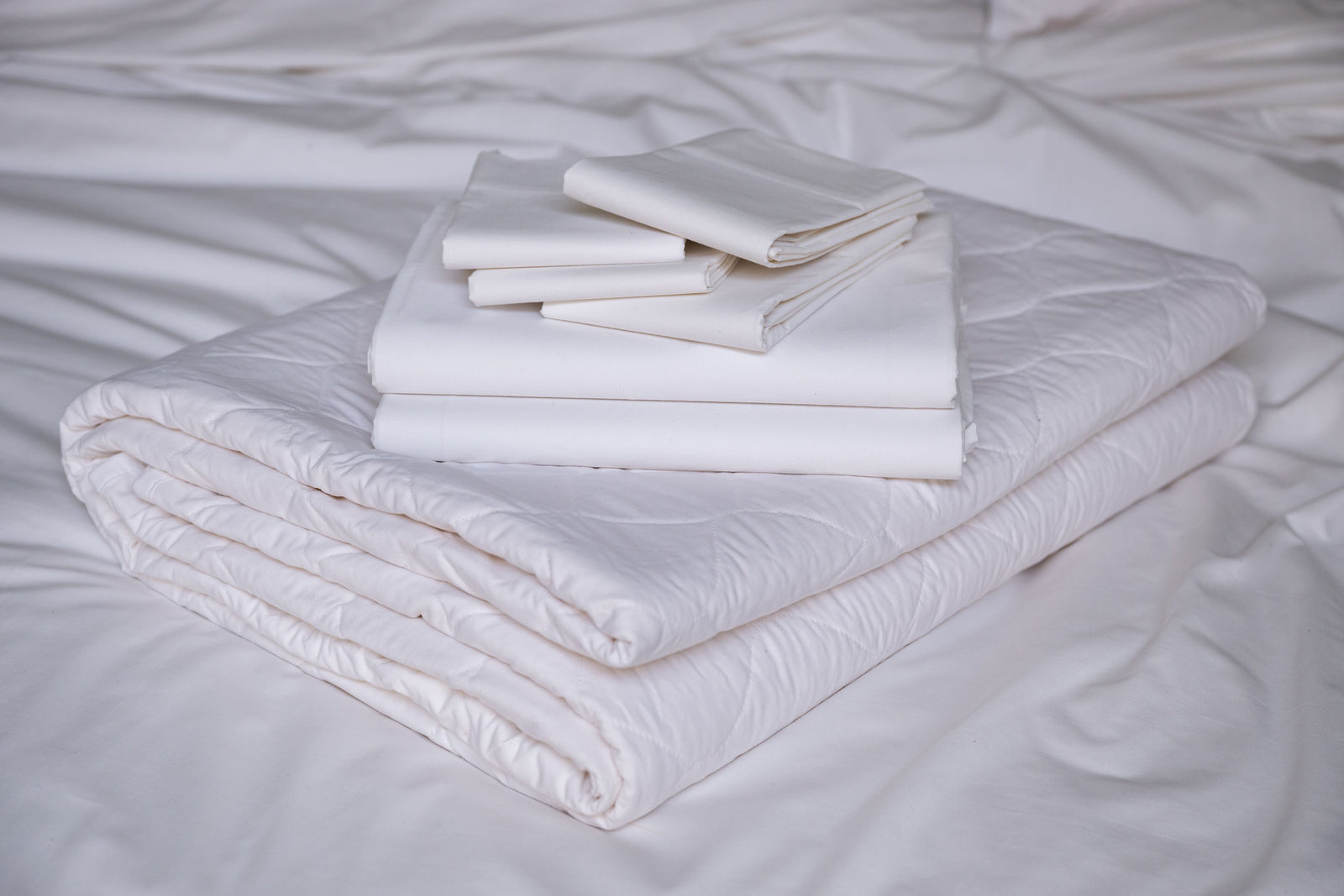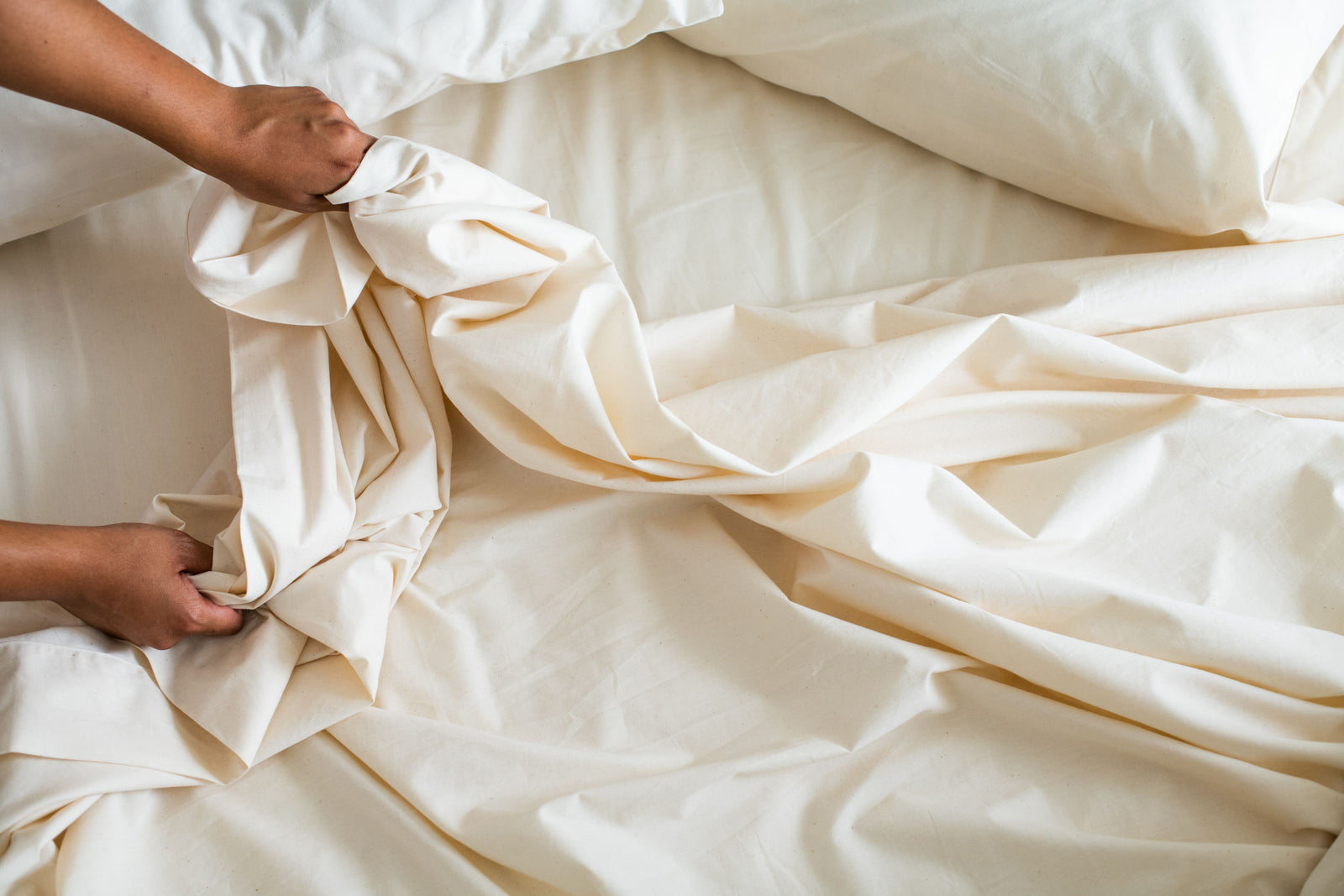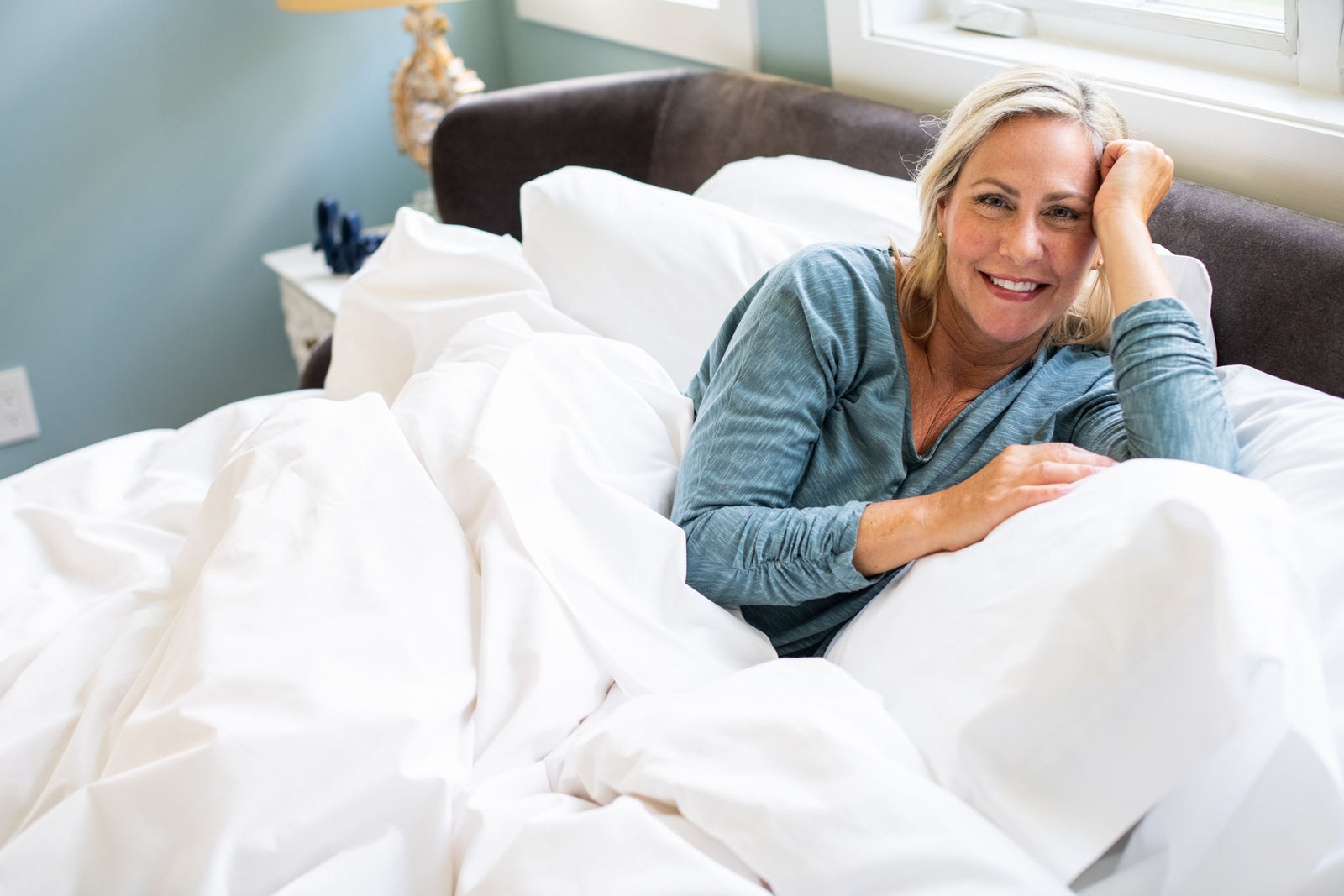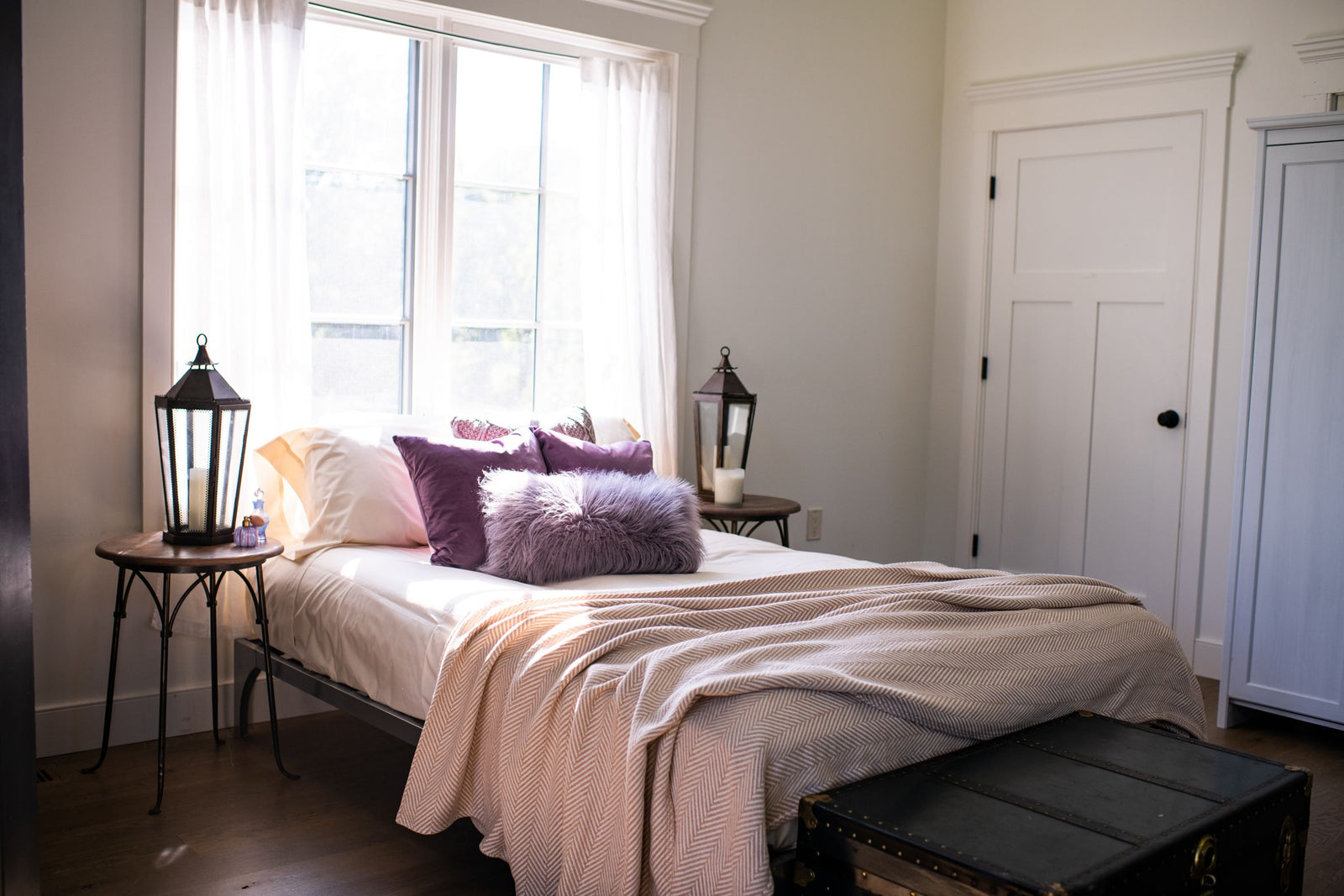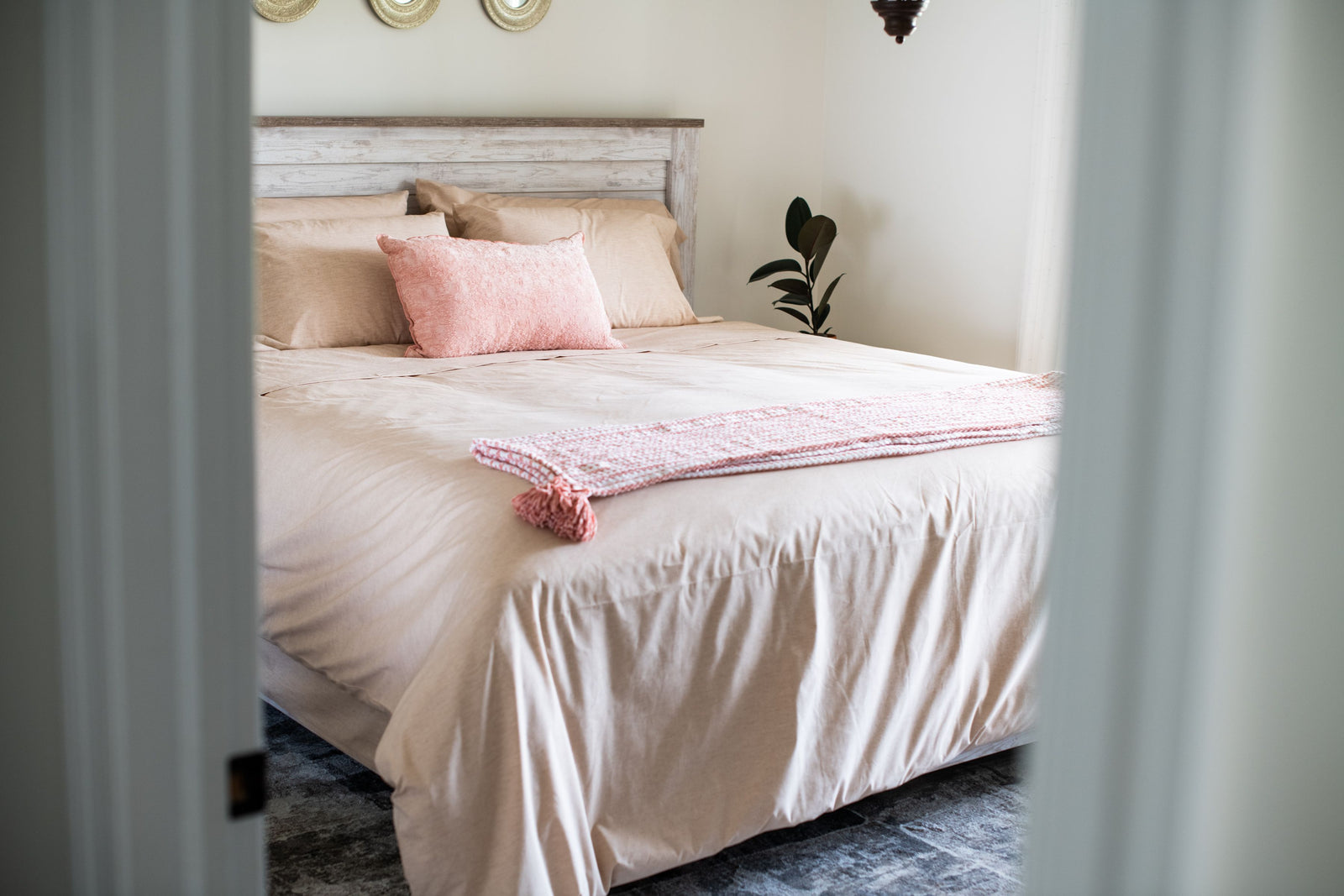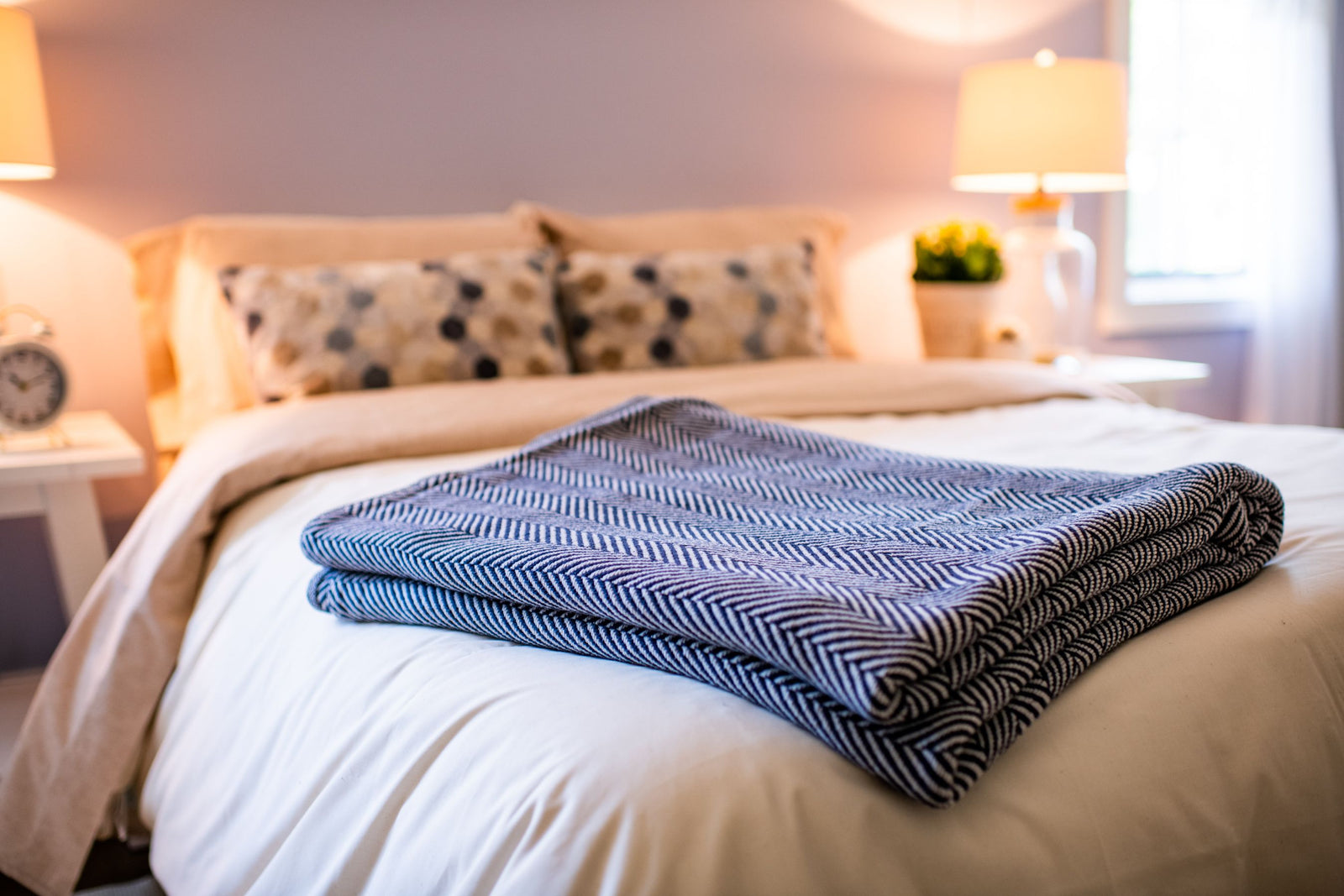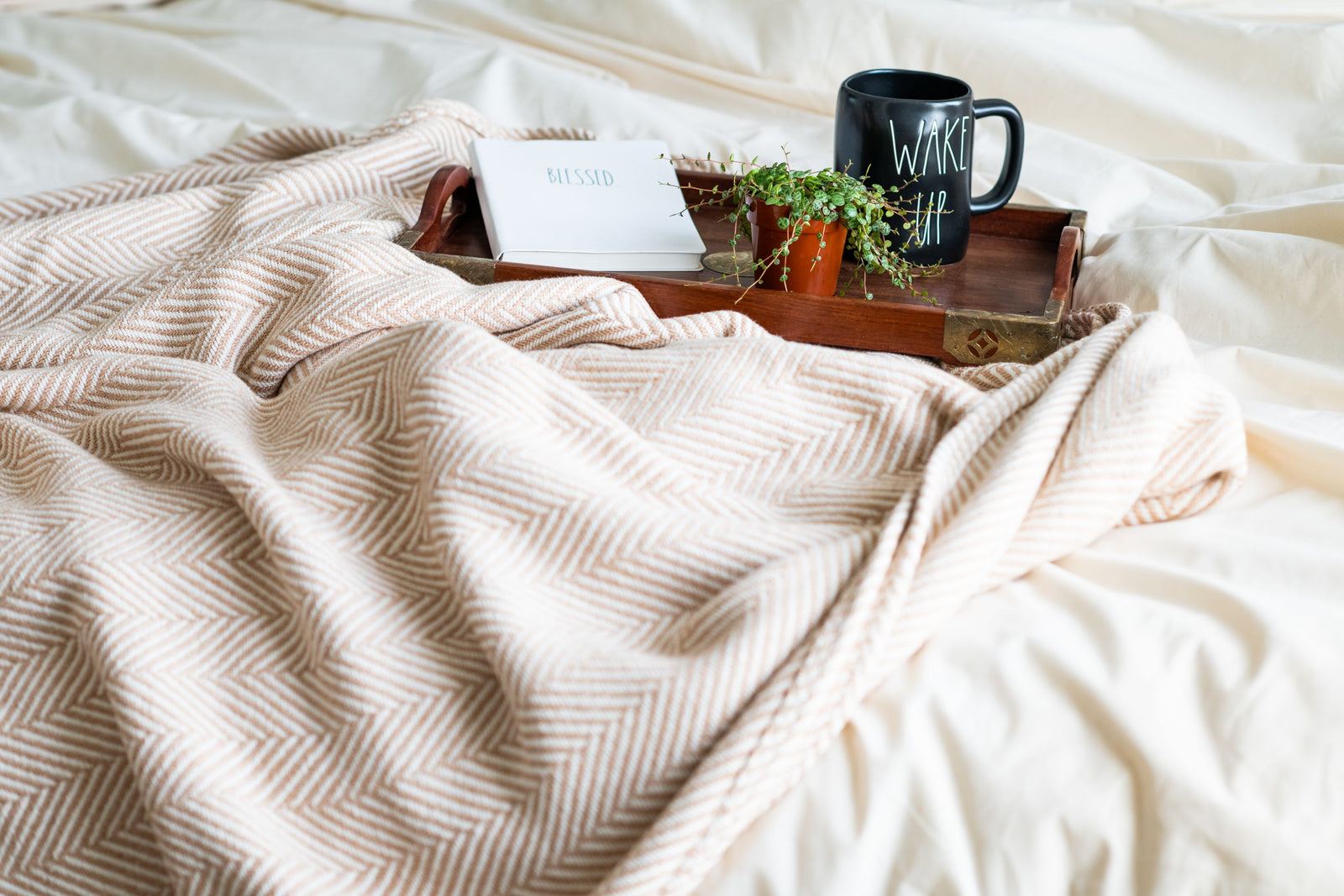A well-layered bed can transform a room from simple to luxurious, offering both comfort and style. Whether you're aiming for a cozy retreat or a chic, high-end look, the art of layering your bed is key to achieving a designer-inspired aesthetic. In this blog, we'll walk you through the essential bedding tips and tricks that interior designers use to create beds that have a visual impact. From choosing the right bedding to mastering the perfect arrangement, these pro tips will help you craft a bed that invites relaxation while exuding sophistication. Ready to elevate your bedroom game? Let’s dive into the details of designer bedding!
A well-layered bed can transform a room from simple to luxurious, offering both comfort and style. Whether you're aiming for a cozy retreat or a chic, high-end look, the art of layering your bed is key to achieving a designer-inspired aesthetic. In this blog, we'll walk you through the essential bedding tips and tricks that interior designers use to create beds that have a visual impact. From choosing the right bedding to mastering the perfect arrangement, these pro tips will help you craft a bed that invites relaxation while exuding sophistication. Ready to elevate your bedroom game? Let’s dive into the details of designer bedding!
Bed layering is the art of arranging multiple layers of bedding to create a visually appealing and comfortable space. It’s about more than just throwing a few cozy blankets, bed pillows or linen sheets on your bed; it's a thoughtful process that adds dimension, texture, and warmth to your sleep area. Mastering the basics of bed layering can make your bed look effortlessly luxurious and inviting.
Bed layering is the art of arranging multiple layers of bedding to create a visually appealing and comfortable space. It’s about more than just throwing a few cozy blankets, bed pillows or linen sheets on your bed; it's a thoughtful process that adds dimension, texture, and warmth to your sleep area. Mastering the basics of bed layering can make your bed look effortlessly luxurious and inviting.
The concept of layering bedding goes beyond just making a bed look good; it's about achieving a balance of style, clean lines, comfort, and practicality. Layers work together to keep you cozy and warm while also elevating the design of your beautiful bedroom. The beauty of bed layering lies in its versatility – it allows you to create a custom look that suits your personal taste, whether you prefer a minimalist approach or a more luxurious,
plush style.
A well-layered bed typically consists of a few key elements:
The concept of layering bedding goes beyond just making a bed look good; it's about achieving a balance of style, clean lines, comfort, and practicality. Layers work together to keep you cozy and warm while also elevating the design of your beautiful bedroom. The beauty of bed layering lies in its versatility – it allows you to create a custom look that suits your personal taste, whether you prefer a minimalist approach or a more luxurious,
plush style.
A well-layered bed typically consists of a few key elements:
To master the art of bed layering, it’s important to understand the key components that make up a well-layered bed. Here’s a breakdown of the essential bedding components to consider when layering your bed.
To master the art of bed layering, it’s important to understand the key components that make up a well-layered bed. Here’s a breakdown of the essential bedding components to consider when layering your bed.
Your mattress is the most essential element of any bed. It provides the support you need for a good night's sleep, and its quality directly affects
the overall comfort of your bed. When selecting, consider the following
factors:
Comfort Level: Mattresses come in various firmness levels, from plush to firm. Choose one that suits your sleeping style and personal preferences.
Size: Make sure it fits your frame and room.
Materials: The materials used, like memory foam, latex, or innerspring, affect both the comfort and durability of the bed.
A quality mattress forms the foundation of your bedding layers, contributing to your overall sleep experience and ensuring your bed looks inviting and polished.
Once you’ve selected the perfect mattress, it’s time to add a mattress protector and/or mattress topper. Though it might seem like an afterthought, a protector serves a vital role in maintaining the cleanliness and longevity of your mattress. Constructed like a fitted sheet, it provides an extra layer keeping dust, allergens, spills, and stains from damaging the mattress, ensuring it remains fresh and hygienic. A mattress topper, also called a mattress pad, is a pad often made with wool, cotton, foam, feathers or latex that lies on top of the mattress protector to add increased protection and an extra layer of cushioning (like sleeping on a cloud). Toppers can be a thicker layer of felt or a quilted pad with elastic bands or a fitted skirt that attaches to the mattress.
Your mattress is the most essential element of any bed. It provides the support you need for a good night's sleep, and its quality directly affects
the overall comfort of your bed. When selecting, consider the following
factors:
Comfort Level: Mattresses come in various firmness levels, from plush to firm. Choose one that suits your sleeping style and personal preferences.
Size: Make sure it fits your frame and room.
Materials: The materials used, like memory foam, latex, or innerspring, affect both the comfort and durability of the bed.
A quality mattress forms the foundation of your bedding layers, contributing to your overall sleep experience and ensuring your bed looks inviting and polished.
Once you’ve selected the perfect mattress, it’s time to add a mattress protector and/or mattress topper. Though it might seem like an afterthought, a protector serves a vital role in maintaining the cleanliness and longevity of your mattress. Constructed like a fitted sheet, it provides an extra layer keeping dust, allergens, spills, and stains from damaging the mattress, ensuring it remains fresh and hygienic. A mattress topper, also called a mattress pad, is a pad often made with wool, cotton, foam, feathers or latex that lies on top of the mattress protector to add increased protection and an extra layer of cushioning (like sleeping on a cloud). Toppers can be a thicker layer of felt or a quilted pad with elastic bands or a fitted skirt that attaches to the mattress.
Once your mattress and protector are in place, the next step in bed layering is adding your favorite sheets. These luxe sheets are the first layers of comfort and serve as the foundation for all the other bedding elements. Choosing the right bedding and ensuring they are properly applied is key to achieving both a cozy feel and a polished look. We think choosing 100% USA cotton breathable sheets ,made from soft material, are the perfect choice for your bed, they offer breathability and they are hypoallergenic; if you are worried about wrinkles, check out our blog: How to Wash Cotton Sheets: A Complete Guide. We also suggest having two sets, one for the bed, and one for when you change the bed and wash the first set. For color, we suggest neutral colors, like natural or white sheets as they offer a clean and classic look.
Once your mattress and protector are in place, the next step in bed layering is adding your favorite sheets. These luxe sheets are the first layers of comfort and serve as the foundation for all the other bedding elements. Choosing the right bedding and ensuring they are properly applied is key to achieving both a cozy feel and a polished look. We think choosing 100% USA cotton breathable sheets ,made from soft material, are the perfect choice for your bed, they offer breathability and they are hypoallergenic; if you are worried about wrinkles, check out our blog: How to Wash Cotton Sheets: A Complete Guide. We also suggest having two sets, one for the bed, and one for when you change the bed and wash the first set. For color, we suggest neutral colors, like natural or white sheets as they offer a clean and classic look.
The Fitted Sheet
The fitted sheet is the first layer that directly contacts your skin. Its primary purpose is to create a smooth, comfortable surface for sleeping. It fits snugly around the mattress, thanks to its elastic corners, ensuring it stays in place through the night. The American Blossom Linens fitted sheet has a wide elastic that goes all around the perimeter to ensure a secure fit by hugging the mattress. A bonus feature for our quality sheets is the "Top or Bottom" labels that are sewn on all fitteds to act as visual cues to help you place it. Learn more about how to keep a fitted sheet on the bed.
The Flat Sheet
The flat lies on top of the fitted and provides an additional layer of comfort between you and the duvet or comforter. The American Blossom Linens flat sheets are cut wider and longer to ensure a secure fit on deeper mattresses.
For a list of suggested sizes, visit our blog: Bed Sheet Sizing Chart and Comprehensive Guide
The Fitted Sheet
The fitted sheet is the first layer that directly contacts your skin. Its primary purpose is to create a smooth, comfortable surface for sleeping. It fits snugly around the mattress, thanks to its elastic corners, ensuring it stays in place through the night. The American Blossom Linens fitted sheet has a wide elastic that goes all around the perimeter to ensure a secure fit by hugging the mattress. A bonus feature for our quality sheets is the "Top or Bottom" labels that are sewn on all fitteds to act as visual cues to help you place it. Learn more about how to keep a fitted sheet on the bed.
The Flat Sheet
The flat lies on top of the fitted and provides an additional layer of comfort between you and the duvet or comforter. The American Blossom Linens flat sheets are cut wider and longer to ensure a secure fit on deeper mattresses.
For a list of suggested sizes, visit our blog: Bed Sheet Sizing Chart and Comprehensive Guide
Next comes a blanket or quilt. There are many styles that you can choose from, like the American Blossom Linens Herringbone Weave Cotton Blanket and the 100% Virgin Wool Lightweight Bed Blanket. We also offer a heirloom quality Cotton Quilted Bedspread in both white and natural. Just like grandma did, on warmer nights when it is too hot to use a cover and insert, a quilt is a perfect lightweight addition. Layer the blanket or bedspread (or both!) over the top sheet.
Next comes a blanket or quilt. There are many styles that you can choose from, like the American Blossom Linens Herringbone Weave Cotton Blanket and the 100% Virgin Wool Lightweight Bed Blanket. We also offer a heirloom quality Cotton Quilted Bedspread in both white and natural. Just like grandma did, on warmer nights when it is too hot to use a cover and insert, a quilt is a perfect lightweight addition. Layer the blanket or bedspread (or both!) over the top sheet.
A comforter is a single piece of bedding with a cover permanently attached to the filling; the filling, or batting, is usually polyester (often called down alternative). A duvet is made up of two pieces, the cover and the insert; they are usually attached to each other in the corners with ties from the cover and loops from the duvet insert. The insert can come with fillings that are feathers, wool or polyester (also called down alternative insert). You can lay the covered insert on top of the sheet and make sure both sides are even. Don’t forget to shake it out before placing it on the bed for maximum fluff.
Should you choose a comforter or duvet set for this layer? This choice is a personal preference. A comforter is much more difficult to wash in standard washing machines and doesn’t offer the versatility of a duvet cover set. Once you choose a decorative comforter you are limited with the style you chose until you replace the bedding set. Using a duvet cover you can switch out as often as you’d like. Try to use a duvet cover with a zipper closure as buttons tend to fall off. A neutral or white duvet cover or linen duvet cover is the perfect backdrop for interesting-colored pillows with lots of textures.
A comforter is a single piece of bedding with a cover permanently attached to the filling; the filling, or batting, is usually polyester (often called down alternative). A duvet is made up of two pieces, the cover and the insert; they are usually attached to each other in the corners with ties from the cover and loops from the duvet insert. The insert can come with fillings that are feathers, wool or polyester (also called down alternative insert). You can lay the covered insert on top of the sheet and make sure both sides are even. Don’t forget to shake it out before placing it on the bed for maximum fluff.
Should you choose a comforter or duvet set for this layer? This choice is a personal preference. A comforter is much more difficult to wash in standard washing machines and doesn’t offer the versatility of a duvet cover set. Once you choose a decorative comforter you are limited with the style you chose until you replace the bedding set. Using a duvet cover you can switch out as often as you’d like. Try to use a duvet cover with a zipper closure as buttons tend to fall off. A neutral or white duvet cover or linen duvet cover is the perfect backdrop for interesting-colored pillows with lots of textures.
When planning how to layer your bed, pillows are a must-have: they bring color, texture, depth, style, and natural comfort. Coordinating with the room’s color palette creates a seamless, thoughtfully styled look for your space.
I’m absolutely obsessed with pillows, so I like to use pillow covers and pillow shams that complement my quilt and duvet cover. I also incorporate different types of pillows, like accent pillows, lumbar pillows, bolster pillows, and of course, sleeping pillows to add variety and coziness.
When planning how to layer your bed, pillows are a must-have: they bring color, texture, depth, style, and natural comfort. Coordinating with the room’s color palette creates a seamless, thoughtfully styled look for your space.
I’m absolutely obsessed with pillows, so I like to use pillow covers and pillow shams that complement my quilt and duvet cover. I also incorporate different types of pillows, like accent pillows, lumbar pillows, bolster pillows, and of course, sleeping pillows to add variety and coziness.
Don’t be afraid to experiment with different combinations and arrangements! Switch things up frequently to keep your bed feeling fresh and dynamic.
Sleep pillows are the larger pillows you rely on for a restful night’s sleep. Typically, each person uses two, though this can vary depending on preference. These come in a range of firmness options, from soft to medium to firm, and different fills such as feathers, polyester, and wool. The right combination of firmness and fill can make all the difference in achieving a comfortable and supportive sleep setup. For more information on our wool filled pillow inserts, visit our blog Benefits of Wool Pillows: Are they Good for Sleep?
Decorative pillows are primarily for aesthetic purposes and are typically removed before going to sleep. They add style and flair to your space, and include options like lumbar, square pillows, euro with euro shams, and accent pillows. While they may not provide the support needed for sleep, they play a key role in enhancing the overall look and feel of your bed and bedroom decor.
Transform your bedroom into a cozy retreat with our step-by-step guide to layering a bed like a pro, from selecting the perfect bed linens to adding the finishing touches.
Don’t be afraid to experiment with different combinations and arrangements! Switch things up frequently to keep your bed feeling fresh and dynamic.
Sleep pillows are the larger pillows you rely on for a restful night’s sleep. Typically, each person uses two, though this can vary depending on preference. These come in a range of firmness options, from soft to medium to firm, and different fills such as feathers, polyester, and wool. The right combination of firmness and fill can make all the difference in achieving a comfortable and supportive sleep setup. For more information on our wool filled pillow inserts, visit our blog Benefits of Wool Pillows: Are they Good for Sleep?
Decorative pillows are primarily for aesthetic purposes and are typically removed before going to sleep. They add style and flair to your space, and include options like lumbar, square pillows, euro with euro shams, and accent pillows. While they may not provide the support needed for sleep, they play a key role in enhancing the overall look and feel of your bed and bedroom decor.
Transform your bedroom into a cozy retreat with our step-by-step guide to layering a bed like a pro, from selecting the perfect bed linens to adding the finishing touches.
You will need to choose a color scheme for your bedding, so use your surroundings for inspiration. For instance, are your walls pink? If
so, you may not want to choose yellow for your bedding as these colors
typically do not mesh well together. You can choose from a variety of prints and patterns too for different pieces of your bedding ensemble.
It is suggested that you use solid-colored bedsheets as your base to start off your layering. Colors like natural or white bedding are perfect timeless classic base colors to start with. You can add other bedding colors and patterns on top via the throws and pillows and blankets.
You will need to choose a color scheme for your bedding, so use your surroundings for inspiration. For instance, are your walls pink? If
so, you may not want to choose yellow for your bedding as these colors
typically do not mesh well together. You can choose from a variety of prints and patterns too for different pieces of your bedding ensemble.
It is suggested that you use solid-colored bedsheets as your base to start off your layering. Colors like natural or white bedding are perfect timeless classic base colors to start with. You can add other bedding colors and patterns on top via the throws and pillows and blankets.
First, you will place the fitted on your bed, be sure the pockets are deep enough for your mattress. The American Blossom Linens product has a 16” deep pocket which works great with depths from 8” – 16”. The elastic on our sheets goes all around the perimeter, so any extra fabric tucks under and since our elastic goes all the way around, the elastic hugs the mattress making for a secure fit.
Next, you will place your flat on your bed. This should be placed upside down, so when you fold the top over, the correct side of the hem
edge is showing. Tuck your flat sheet under your mattress. It is suggested that you use hospital corners for a smooth look. Here is a thorough explanation of how to make hospital corners. Hospital corners ensure
smooth draping for the other layers.
Next, you will add your blanket, a layer of warmth. This should be tucked under the mattress along with your flat sheet.
Finally, you add the other layers which do not get tucked. You can add a quilted bedspread with a duvet on top, or a duvet with a quilted bedspread on top or just a duvet or bedspread alone. This is a personal preference. You may need to try different placements to get the look you like the best.
How many pillows should you use? The answer is an odd number. Designers generally recommend three, five or seven depending on your
bed size. A queen bed or king bed would use five or seven, while a twin would use three and a full bed would use three to five.
Place your sleeping ones first, against the headboard. This is the base. A nice detail to add is to have some plain pillowcases and some with a classic piping design. Then you would add your square Euro pillows. Next is the lumbar or throw pillows. Finally, small pillows can be added for a decorative element. Usually only one decorative pillow is used for any bed size and many designers say to bring a pop of color here.
First, you will place the fitted on your bed, be sure the pockets are deep enough for your mattress. The American Blossom Linens product has a 16” deep pocket which works great with depths from 8” – 16”. The elastic on our sheets goes all around the perimeter, so any extra fabric tucks under and since our elastic goes all the way around, the elastic hugs the mattress making for a secure fit.
Next, you will place your flat on your bed. This should be placed upside down, so when you fold the top over, the correct side of the hem
edge is showing. Tuck your flat sheet under your mattress. It is suggested that you use hospital corners for a smooth look. Here is a thorough explanation of how to make hospital corners. Hospital corners ensure
smooth draping for the other layers.
Next, you will add your blanket, a layer of warmth. This should be tucked under the mattress along with your flat sheet.
Finally, you add the other layers which do not get tucked. You can add a quilted bedspread with a duvet on top, or a duvet with a quilted bedspread on top or just a duvet or bedspread alone. This is a personal preference. You may need to try different placements to get the look you like the best.
How many pillows should you use? The answer is an odd number. Designers generally recommend three, five or seven depending on your
bed size. A queen bed or king bed would use five or seven, while a twin would use three and a full bed would use three to five.
Place your sleeping ones first, against the headboard. This is the base. A nice detail to add is to have some plain pillowcases and some with a classic piping design. Then you would add your square Euro pillows. Next is the lumbar or throw pillows. Finally, small pillows can be added for a decorative element. Usually only one decorative pillow is used for any bed size and many designers say to bring a pop of color here.
Now all that is left are the final touches. You can add a throw blanket or bed runner to the end of the bed. These can both be placed neatly at the foot of the bed, or you can drape the cotton or wool throw blanket. Having a blanket at the end of the bed makes it easy to find and use while reading or watching TV. A few extra blankets can be placed in a little basket next to the bed.
Now all that is left are the final touches. You can add a throw blanket or bed runner to the end of the bed. These can both be placed neatly at the foot of the bed, or you can drape the cotton or wool throw blanket. Having a blanket at the end of the bed makes it easy to find and use while reading or watching TV. A few extra blankets can be placed in a little basket next to the bed.
Master the art of seasonal bed layering with expert tips on adjusting your bedding for warmth, comfort, and style, no matter the time of year.
You may choose to use less layers during the summer months. Only using a bedspread or blanket is a common choice. Alternatively, using a lighter
weight duvet insert is an option too.
During the colder months, you can use as many layers as you feel comfortable. Adding a blanket, a bedspread and an insert and cover is a common choice. Some people use two duvet covers or an extra blanket for extra warmth. A nice design tip is to take your fluffy insert and cover and fold it in thirds like an accordion, at the bottom of the bed so all you have to do is pull it up at night on top of the blankets for a perfect snuggle. You can also place it over the entire bed and just fold down a small portion of it so that the bed blanket beneath will peak through.
Avoid common bed layering mistakes with these simple tips to ensure your bed looks stylish, feels cozy, and is perfectly arranged every time
You always want to keep your layers balanced, using too many bulky items may make the bed look overdone. Combining soft bed linens, thin blankets and fluffy duvets, while maintaining symmetry with the pillows will give a more appealing look.
See our frequently asked questions to achieve a designer-inspired look with expert bed layering techniques that blend style, texture, and comfort for a sophisticated, inviting space.
Frankly there really is no correct way to layer a bed. It all depends on personal preference, if after the sheets you add a blanket, quilt and comforter or you add a comforter, quilt and blanket. The order is up to you.
Adding personal touches makes a more luxurious space. For example, adding colored piping pillowcases or a matching bed skirt is a traditional classic look recommended by many designers. Add a tray on the bed that is seasonally designed with a good smelling candle and your favorite book or better yet flowers on the nightstand.
Master the art of seasonal bed layering with expert tips on adjusting your bedding for warmth, comfort, and style, no matter the time of year.
You may choose to use less layers during the summer months. Only using a bedspread or blanket is a common choice. Alternatively, using a lighter
weight duvet insert is an option too.
During the colder months, you can use as many layers as you feel comfortable. Adding a blanket, a bedspread and an insert and cover is a common choice. Some people use two duvet covers or an extra blanket for extra warmth. A nice design tip is to take your fluffy insert and cover and fold it in thirds like an accordion, at the bottom of the bed so all you have to do is pull it up at night on top of the blankets for a perfect snuggle. You can also place it over the entire bed and just fold down a small portion of it so that the bed blanket beneath will peak through.
Avoid common bed layering mistakes with these simple tips to ensure your bed looks stylish, feels cozy, and is perfectly arranged every time
You always want to keep your layers balanced, using too many bulky items may make the bed look overdone. Combining soft bed linens, thin blankets and fluffy duvets, while maintaining symmetry with the pillows will give a more appealing look.
See our frequently asked questions to achieve a designer-inspired look with expert bed layering techniques that blend style, texture, and comfort for a sophisticated, inviting space.
Frankly there really is no correct way to layer a bed. It all depends on personal preference, if after the sheets you add a blanket, quilt and comforter or you add a comforter, quilt and blanket. The order is up to you.
Adding personal touches makes a more luxurious space. For example, adding colored piping pillowcases or a matching bed skirt is a traditional classic look recommended by many designers. Add a tray on the bed that is seasonally designed with a good smelling candle and your favorite book or better yet flowers on the nightstand.
The key to styling like a designer is to know your style. Knowing it will help you choose bedding that will accomplish your decorative purposes.
Some style examples include the all-white classic year-round bed or the
monochromatic modern sophisticated bed which layers tonal variations of one color such as our natural sheets, natural quilt and American Harvest Blanket. How about the disheveled bed, an inviting, warm, comfortable look that invites sleep. Just lay out your sheets but pull back the quilt and blanket a little.
The key to styling like a designer is to know your style. Knowing it will help you choose bedding that will accomplish your decorative purposes.
Some style examples include the all-white classic year-round bed or the
monochromatic modern sophisticated bed which layers tonal variations of one color such as our natural sheets, natural quilt and American Harvest Blanket. How about the disheveled bed, an inviting, warm, comfortable look that invites sleep. Just lay out your sheets but pull back the quilt and blanket a little.
Hotels often use a technique called triple sheeting. They will add a second flat on top of the duvet or blanket in addition to the flat and fitted sheet underneath. In essence the second flat serves as a duvet cover. This is done as flat sheets are much easier to place on the bed than a duvet cover and hotels look for ways to quickly layer beds. Also add extra pillows against your headboard to get that boutique hotel bed feel.
Layering a bed like a designer is all about creating texture, depth, and a sense of coziness. By adding pillows, throws, and the right bedding in complementary colors or patterns, you can elevate the look without it feeling overwhelming. Also remember that spending a bit more on bedding that is made of better materials will pay off in terms of style, last longer and save money in the long run. But please understand that rules are meant to be broken and the main point here is to have fun and create a space that YOU love, setting you up for that great night’s sleep.
Hotels often use a technique called triple sheeting. They will add a second flat on top of the duvet or blanket in addition to the flat and fitted sheet underneath. In essence the second flat serves as a duvet cover. This is done as flat sheets are much easier to place on the bed than a duvet cover and hotels look for ways to quickly layer beds. Also add extra pillows against your headboard to get that boutique hotel bed feel.
Layering a bed like a designer is all about creating texture, depth, and a sense of coziness. By adding pillows, throws, and the right bedding in complementary colors or patterns, you can elevate the look without it feeling overwhelming. Also remember that spending a bit more on bedding that is made of better materials will pay off in terms of style, last longer and save money in the long run. But please understand that rules are meant to be broken and the main point here is to have fun and create a space that YOU love, setting you up for that great night’s sleep.
